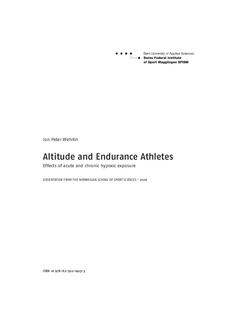| dc.contributor.author | Wehrlin, Jon Peter | |
| dc.date.accessioned | 2009-04-07T10:13:43Z | |
| dc.date.issued | 2008 | |
| dc.identifier | Seksjon for fysisk prestasjonsevne / Department of Physical Performance | |
| dc.identifier.isbn | 978-82-502-0413-3 | |
| dc.identifier.uri | http://hdl.handle.net/11250/171271 | |
| dc.description | Avhandling (doktorgrad) – Norges idrettshøgskole, 2008. | en |
| dc.description.abstract | “How does altitude affect performance"? This question has been asked by athletes, coaches and sport scientists for many years. Most of the current interest in altitude and altitude training can be traced back to the 1968 Summer Olympic Games held in Mexico City at an
elevation of 2300m. At the 1968 Olympics, sprinters and jumpers in the sport of track and field set several world records in the “thin air” of Mexico City, whereas the distance runners ran markedly slower compared with 1968 world records. Interestingly, athletes from countries with moderate altitude such as Kenya and Ethiopia won a relatively high percentage of medals in the middle and long distance races (153). Since then, interest in altitude and altitude training has continued to grow. More recently, important endurance competitions, such as the Olympic Games (Salt Lake 2002 and Torino 2006) have taken place at low (1000 - 2000m) and moderate (2000 - 3000m) altitudes making it important to acclimatize in an optimal way for the target altitude. Furthermore, new altitude training concepts have been introduced with the goal of utilizing altitude in order to improve endurance performance not only at altitude, but at sea-level as well. | en |
| dc.description.abstract | Paper I: Tatt ut av filen i Brage p.g.a. copyright-restriksjoner. / Not in the file in Brage because of copyright issues. | |
| dc.description.abstract | Paper II: Jon Peter Wehrlin, Peter Zuest, Jostein Hallén, Bernard Marti. Live high-train low for 24 days increases hemoglobin mass and red cell volume in elite endurance athletes. J Appl Physiol. 100(6):1938-1945, 2006 | |
| dc.description.abstract | Paper III: Jon Peter Wehrlin, Bernard Marti. Live high-train low associated with increased haemogobin mass as preparation for the 2003 World Championships in two native European world-class runners. Br J Sports Med. 40:e3, 2006 | |
| dc.description.abstract | Paper IV: Tatt ut av filen i Brage p.g.a. copyright-restriksjoner. / Not in the file in Brage because of copyright issues. | |
| dc.format.extent | 5854856 bytes | |
| dc.format.mimetype | application/pdf | |
| dc.language.iso | eng | en |
| dc.publisher | The Norwegian School of Sport Sciences | en |
| dc.subject | idrett | en |
| dc.subject | høydetrening | en |
| dc.subject | utholdenhet | en |
| dc.subject | hypoksi | en |
| dc.subject | maksimalt oksygenopptak | en |
| dc.subject | prestasjoner | en |
| dc.subject | utøvere | en |
| dc.title | Altitude and endurance athletes : effects of acute and chronic hypoxic exposure | en |
| dc.type | Doctoral thesis | en |
| dc.subject.nsi | VDP::Social science: 200::Social science in sports: 330::Other subjects within physical education: 339 | |
| dc.subject.nsi | VDP::Mathematics and natural science: 400::Basic biosciences: 470 | |
